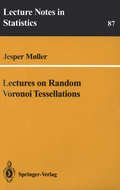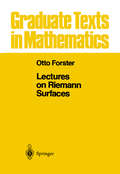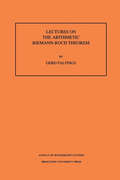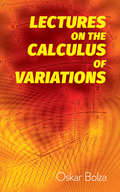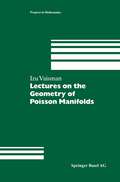- Table View
- List View
Lectures on Random Interfaces (SpringerBriefs in Probability and Mathematical Statistics #2)
by Tadahisa FunakiInterfaces are created to separate two distinct phases in a situation in which phase coexistence occurs. This book discusses randomly fluctuating interfaces in several different settings and from several points of view: discrete/continuum, microscopic/macroscopic, and static/dynamic theories. The following four topics in particular are dealt with in the book.Assuming that the interface is represented as a height function measured from a fixed-reference discretized hyperplane, the system is governed by the Hamiltonian of gradient of the height functions. This is a kind of effective interface model called ∇φ-interface model. The scaling limits are studied for Gaussian (or non-Gaussian) random fields with a pinning effect under a situation in which the rate functional of the corresponding large deviation principle has non-unique minimizers.Young diagrams determine decreasing interfaces, and their dynamics are introduced. The large-scale behavior of such dynamics is studied from the points of view of the hydrodynamic limit and non-equilibrium fluctuation theory. Vershik curves are derived in that limit.A sharp interface limit for the Allen–Cahn equation, that is, a reaction–diffusion equation with bistable reaction term, leads to a mean curvature flow for the interfaces. Its stochastic perturbation, sometimes called a time-dependent Ginzburg–Landau model, stochastic quantization, or dynamic P(φ)-model, is considered. Brief introductions to Brownian motions, martingales, and stochastic integrals are given in an infinite dimensional setting. The regularity property of solutions of stochastic PDEs (SPDEs) of a parabolic type with additive noises is also discussed.The Kardar–Parisi–Zhang (KPZ) equation , which describes a growing interface with fluctuation, recently has attracted much attention. This is an ill-posed SPDE and requires a renormalization. Especially its invariant measures are studied.
Lectures on Random Voronoi Tessellations (Lecture Notes in Statistics #87)
by Jesper MollerTessellations are subdivisions of d-dimensional space into non-overlapping "cells". Voronoi tessellations are produced by first considering a set of points (known as nuclei) in d-space, and then defining cells as the set of points which are closest to each nuclei. A random Voronoi tessellation is produced by supposing that the location of each nuclei is determined by some random process. They provide models for many natural phenomena as diverse as the growth of crystals, the territories of animals, the development of regional market areas, and in subjects such as computational geometry and astrophysics. This volume provides an introduction to random Voronoi tessellations by presenting a survey of the main known results and the directions in which research is proceeding. Throughout the volume, mathematical and rigorous proofs are given making this essentially a self-contained account in which no background knowledge of the subject is assumed.
Lectures on Resolution of Singularities (AM-166)
by János KollárResolution of singularities is a powerful and frequently used tool in algebraic geometry. In this book, János Kollár provides a comprehensive treatment of the characteristic 0 case. He describes more than a dozen proofs for curves, many based on the original papers of Newton, Riemann, and Noether. Kollár goes back to the original sources and presents them in a modern context. He addresses three methods for surfaces, and gives a self-contained and entirely elementary proof of a strong and functorial resolution in all dimensions. Based on a series of lectures at Princeton University and written in an informal yet lucid style, this book is aimed at readers who are interested in both the historical roots of the modern methods and in a simple and transparent proof of this important theorem.
Lectures on Riemann Surfaces (Graduate Texts in Mathematics #81)
by Otto ForsterThis book grew out of lectures on Riemann surfaces given by Otto Forster at the universities of Munich, Regensburg, and Münster. It provides a concise modern introduction to this rewarding subject, as well as presenting methods used in the study of complex manifolds in the special case of complex dimension one. From the reviews: "This book deserves very serious consideration as a text for anyone contemplating giving a course on Riemann surfaces."—-MATHEMATICAL REVIEWS
Lectures on Riemann Surfaces: Jacobi Varieties
by Robert C. GunningA sequel to Lectures on Riemann Surfaces (Mathematical Notes, 1966), this volume continues the discussion of the dimensions of spaces of holomorphic cross-sections of complex line bundles over compact Riemann surfaces. Whereas the earlier treatment was limited to results obtainable chiefly by one-dimensional methods, the more detailed analysis presented here requires the use of various properties of Jacobi varieties and of symmetric products of Riemann surfaces, and so serves as a further introduction to these topics as well.The first chapter consists of a rather explicit description of a canonical basis for the Abelian differentials on a marked Riemann surface, and of the description of the canonical meromorphic differentials and the prime function of a marked Riemann surface. Chapter 2 treats Jacobi varieties of compact Riemann surfaces and various subvarieties that arise in determining the dimensions of spaces of holomorphic cross-sections of complex line bundles. In Chapter 3, the author discusses the relations between Jacobi varieties and symmetric products of Riemann surfaces relevant to the determination of dimensions of spaces of holomorphic cross-sections of complex line bundles. The final chapter derives Torelli's theorem following A. Weil, but in an analytical context.Originally published in 1973.The Princeton Legacy Library uses the latest print-on-demand technology to again make available previously out-of-print books from the distinguished backlist of Princeton University Press. These editions preserve the original texts of these important books while presenting them in durable paperback and hardcover editions. The goal of the Princeton Legacy Library is to vastly increase access to the rich scholarly heritage found in the thousands of books published by Princeton University Press since its founding in 1905.
Lectures on Seiberg-Witten Invariants (Lecture Notes in Mathematics #1629)
by John D. MooreRiemannian, symplectic and complex geometry are often studied by means ofsolutions to systems ofnonlinear differential equations, such as the equa tions of geodesics, minimal surfaces, pseudoholomorphic curves and Yang Mills connections. For studying such equations, a new unified technology has been developed, involving analysis on infinite-dimensional manifolds. A striking applications of the new technology is Donaldson's theory of "anti-self-dual" connections on SU(2)-bundles over four-manifolds, which applies the Yang-Mills equations from mathematical physics to shed light on the relationship between the classification of topological and smooth four-manifolds. This reverses the expected direction of application from topology to differential equations to mathematical physics. Even though the Yang-Mills equations are only mildly nonlinear, a prodigious amount of nonlinear analysis is necessary to fully understand the properties of the space of solutions. . At our present state of knowledge, understanding smooth structures on topological four-manifolds seems to require nonlinear as opposed to linear PDE's. It is therefore quite surprising that there is a set of PDE's which are even less nonlinear than the Yang-Mills equation, but can yield many of the most important results from Donaldson's theory. These are the Seiberg-Witte~ equations. These lecture notes stem from a graduate course given at the University of California in Santa Barbara during the spring quarter of 1995. The objective was to make the Seiberg-Witten approach to Donaldson theory accessible to second-year graduate students who had already taken basic courses in differential geometry and algebraic topology.
Lectures on Seiberg-Witten Invariants (Lecture Notes in Mathematics #1629)
by John D. MooreIn the fall of 1994, Edward Witten proposed a set of equations which give the main results of Donaldson theory in a far simpler way than had been thought possible. The purpose of these notes is to provide an elementary introduction to the equations that Witten proposed. They are directed towards graduate students who have already taken a basic course in differential geometry and topology.
Lectures on Several Complex Variables
by Paul M. GauthierThis monograph provides a concise, accessible snapshot of key topics in several complex variables, including the Cauchy Integral Formula, sequences of holomorphic functions, plurisubharmonic functions, the Dirichlet problem, and meromorphic functions. Based on a course given at Université de Montréal, this brief introduction covers areas of contemporary importance that are not mentioned in most treatments of the subject, such as modular forms, which are essential for Wiles' theorem and the unification of quantum theory and general relativity. Also covered is the Riemann manifold of a function, which generalizes the Riemann surface of a function of a single complex variable and is a topic that is well-known in one complex variable, but rarely treated in several variables. Many details, which are intentionally left out, as well as many theorems are stated as problems, providing students with carefully structured instructive exercises. Prerequisites for use of this book are functions of one complex variable, functions of several real variables, and topology, all at the undergraduate level. Lectures on Several Complex Variables will be of interest to advanced undergraduate and beginning undergraduate students, as well as mathematical researchers and professors.
Lectures on Spaces of Nonpositive Curvature (Oberwolfach Seminars #25)
by Werner BallmannSingular spaces with upper curvature bounds and, in particular, spaces of nonpositive curvature, have been of interest in many fields, including geometric (and combinatorial) group theory, topology, dynamical systems and probability theory. In the first two chapters of the book, a concise introduction into these spaces is given, culminating in the Hadamard-Cartan theorem and the discussion of the ideal boundary at infinity for simply connected complete spaces of nonpositive curvature. In the third chapter, qualitative properties of the geodesic flow on geodesically complete spaces of nonpositive curvature are discussed, as are random walks on groups of isometries of nonpositively curved spaces. The main class of spaces considered should be precisely complementary to symmetric spaces of higher rank and Euclidean buildings of dimension at least two (Rank Rigidity conjecture). In the smooth case, this is known and is the content of the Rank Rigidity theorem. An updated version of the proof of the latter theorem (in the smooth case) is presented in Chapter IV of the book. This chapter contains also a short introduction into the geometry of the unit tangent bundle of a Riemannian manifold and the basic facts about the geodesic flow. In an appendix by Misha Brin, a self-contained and short proof of the ergodicity of the geodesic flow of a compact Riemannian manifold of negative curvature is given. The proof is elementary and should be accessible to the non-specialist. Some of the essential features and problems of the ergodic theory of smooth dynamical systems are discussed, and the appendix can serve as an introduction into this theory.
Lectures on Sphere Arrangements – the Discrete Geometric Side (Fields Institute Monographs #32)
by Károly BezdekThis monograph gives a short introduction to the relevant modern parts of discrete geometry, in addition to leading the reader to the frontiers of geometric research on sphere arrangements. The readership is aimed at advanced undergraduate and early graduate students, as well as interested researchers. It contains more than 40 open research problems ideal for graduate students and researchers in mathematics and computer science. Additionally, this book may be considered ideal for a one-semester advanced undergraduate or graduate level course. The core part of this book is based on three lectures given by the author at the Fields Institute during the thematic program on “Discrete Geometry and Applications” and contains four core topics. The first two topics surround active areas that have been outstanding from the birth of discrete geometry, namely dense sphere packings and tilings. Sphere packings and tilings have a very strong connection to number theory, coding, groups, and mathematical programming. Extending the tradition of studying packings of spheres, is the investigation of the monotonicity of volume under contractions of arbitrary arrangements of spheres. The third major topic of this book can be found under the sections on ball-polyhedra that study the possibility of extending the theory of convex polytopes to the family of intersections of congruent balls. This section of the text is connected in many ways to the above-mentioned major topics and it is also connected to some other important research areas as the one on coverings by planks (with close ties to geometric analysis). This fourth core topic is discussed under covering balls by cylinders.
Lectures on the Arithmetic Riemann-Roch Theorem. (AM-127), Volume 127
by Gerd FaltingsThe arithmetic Riemann-Roch Theorem has been shown recently by Bismut-Gillet-Soul. The proof mixes algebra, arithmetic, and analysis. The purpose of this book is to give a concise introduction to the necessary techniques, and to present a simplified and extended version of the proof. It should enable mathematicians with a background in arithmetic algebraic geometry to understand some basic techniques in the rapidly evolving field of Arakelov-theory.
Lectures on the Automorphism Groups of Kobayashi-Hyperbolic Manifolds (Lecture Notes in Mathematics #1902)
by Alexander IsaevIn this monograph the author presents a coherent exposition of recent results on complete characterization of Kobayashi-hyperbolic manifolds with high-dimensional groups of holomorphic automorphisms. These classification results can be viewed as complex-geometric analogues of those known for Riemannian manifolds with high-dimensional isotropy groups that were extensively studied in the 1950s-70s.
Lectures on the Calculus of Variations (Dover Books on Mathematics)
by Oskar BolzaThis pioneering modern treatise on the calculus of variations studies the evolution of the subject from Euler to Hilbert. The text addresses basic problems with sufficient generality and rigor to offer a sound introduction for serious study. It provides clear definitions of the fundamental concepts, sharp formulations of the problems, and rigorous demonstrations of their solutions. Many examples are solved completely, and systematic references are given for each theorem upon its first appearance. Initial chapters address the first and second variation of the integral, and succeeding chapters cover the sufficient conditions for an extremum of the integral and Weierstrass's theory of the problem in parameter-representation; Kneser's extension of Weierstrass's theory to cover the case of variable end-points; and Weierstrass's theory of the isoperimetric problems. The final chapter presents a thorough proof of Hilbert's existence theorem.
Lectures on the Eilenberg-Moore Spectral Sequence (Lecture Notes in Mathematics #134)
by Larry SmithLectures on the Geometry of Numbers
by Carl Ludwig SiegelCarl Ludwig Siegel gave a course of lectures on the Geometry of Numbers at New York University during the academic year 1945-46, when there were hardly any books on the subject other than Minkowski's original one. This volume stems from Siegel's requirements of accuracy in detail, both in the text and in the illustrations, but involving no changes in the structure and style of the lectures as originally delivered. This book is an enticing introduction to Minkowski's great work. It also reveals the workings of a remarkable mind, such as Siegel's with its precision and power and aesthetic charm. It is of interest to the aspiring as well as the established mathematician, with its unique blend of arithmetic, algebra, geometry, and analysis, and its easy readability.
Lectures on the H-Cobordism Theorem
by John MilnorThese lectures provide students and specialists with preliminary and valuable information from university courses and seminars in mathematics. This set gives new proof of the h-cobordism theorem that is different from the original proof presented by S. Smale.Originally published in 1965.The Princeton Legacy Library uses the latest print-on-demand technology to again make available previously out-of-print books from the distinguished backlist of Princeton University Press. These editions preserve the original texts of these important books while presenting them in durable paperback and hardcover editions. The goal of the Princeton Legacy Library is to vastly increase access to the rich scholarly heritage found in the thousands of books published by Princeton University Press since its founding in 1905.
Lectures on the Hyperreals: An Introduction to Nonstandard Analysis (Graduate Texts in Mathematics #188)
by Robert GoldblattAn introduction to nonstandard analysis based on a course given by the author. It is suitable for beginning graduates or upper undergraduates, or for self-study by anyone familiar with elementary real analysis. It presents nonstandard analysis not just as a theory about infinitely small and large numbers, but as a radically different way of viewing many standard mathematical concepts and constructions. It is a source of new ideas, objects and proofs, and a wealth of powerful new principles of reasoning. The book begins with the ultrapower construction of hyperreal number systems, and proceeds to develop one-variable calculus, analysis and topology from the nonstandard perspective. It then sets out the theory of enlargements of fragments of the mathematical universe, providing a foundation for the full-scale development of the nonstandard methodology. The final chapters apply this to a number of topics, including Loeb measure theory and its relation to Lebesgue measure on the real line. Highlights include an early introduction of the ideas of internal, external and hyperfinite sets, and a more axiomatic set-theoretic approach to enlargements than is usual.
Lectures on the Mathematics of Quantum Mechanics I (Atlantis Studies in Mathematical Physics: Theory and Applications #1)
by Gianfausto Dell'AntonioThe first volume (General Theory) differs from most textbooks as it emphasizes the mathematical structure and mathematical rigor, while being adapted to the teaching the first semester of an advanced course in Quantum Mechanics (the content of the book are the lectures of courses actually delivered.). It differs also from the very few texts in Quantum Mechanics that give emphasis to the mathematical aspects because this book, being written as Lecture Notes, has the structure of lectures delivered in a course, namely introduction of the problem, outline of the relevant points, mathematical tools needed, theorems, proofs. This makes this book particularly useful for self-study and for instructors in the preparation of a second course in Quantum Mechanics (after a first basic course). With some minor additions it can be used also as a basis of a first course in Quantum Mechanics for students in mathematics curricula. The second part (Selected Topics) are lecture notes of a more advanced course aimed at giving the basic notions necessary to do research in several areas of mathematical physics connected with quantum mechanics, from solid state to singular interactions, many body theory, semi-classical analysis, quantum statistical mechanics. The structure of this book is suitable for a second-semester course, in which the lectures are meant to provide, in addition to theorems and proofs, an overview of a more specific subject and hints to the direction of research. In this respect and for the width of subjects this second volume differs from other monographs on Quantum Mechanics. The second volume can be useful for students who want to have a basic preparation for doing research and for instructors who may want to use it as a basis for the presentation of selected topics.
Lectures on the Mathematics of Quantum Mechanics II: Selected Topics (Atlantis Studies in Mathematical Physics: Theory and Applications #2)
by Gianfausto Dell'AntonioThe first volume (General Theory) differs from most textbooks as it emphasizes the mathematical structure and mathematical rigor, while being adapted to the teaching the first semester of an advanced course in Quantum Mechanics (the content of the book are the lectures of courses actually delivered.). It differs also from the very few texts in Quantum Mechanics that give emphasis to the mathematical aspects because this book, being written as Lecture Notes, has the structure of lectures delivered in a course, namely introduction of the problem, outline of the relevant points, mathematical tools needed, theorems, proofs. This makes this book particularly useful for self-study and for instructors in the preparation of a second course in Quantum Mechanics (after a first basic course). With some minor additions it can be used also as a basis of a first course in Quantum Mechanics for students in mathematics curricula. The second part (Selected Topics) are lecture notes of a more advanced course aimed at giving the basic notions necessary to do research in several areas of mathematical physics connected with quantum mechanics, from solid state to singular interactions, many body theory, semi-classical analysis, quantum statistical mechanics. The structure of this book is suitable for a second-semester course, in which the lectures are meant to provide, in addition to theorems and proofs, an overview of a more specific subject and hints to the direction of research. In this respect and for the width of subjects this second volume differs from other monographs on Quantum Mechanics. The second volume can be useful for students who want to have a basic preparation for doing research and for instructors who may want to use it as a basis for the presentation of selected topics.
Lectures on the Mechanical Foundations of Thermodynamics (SpringerBriefs in Physics)
by Michele CampisiThis brief provides a modern pedagogical exposition of the mechanical approach to statistical mechanics initiated by Boltzmann with his early works (1866-1871). Despite the later contribution by Helmholtz, Boltzmann himself (1884-1887), Gibbs, P. Hertz, and Einstein, the mechanical approach remained almost unknown to the modern reader, in favour of the celebrated combinatorial approach, developed by Boltzmann himself during his probabilistic turn (1876-1884). The brief constitutes an ideal continuation of a graduate course of classical mechanics and requires knowledge of basic calculus in many dimension (including differential forms), thermodynamics, probability theory, besides Hamiltonian mechanics. The cornerstone of the whole presentation is the ergodic hypothesis. Special attention is devoted to Massieu potentials (the Legendre transforms of the entropy) which are most natural in statistical mechanics, and also allow for a more direct treatment of the topic of ensemble equivalence.

